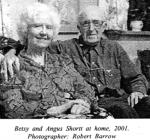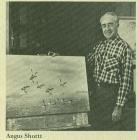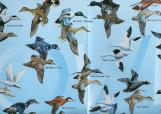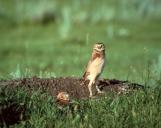1
Angus Shortt praising of the St. James Council's decision to set aside the tall grass prairie site27 January 1971

3
...black wavy hair. And wow, that was nice enough to start with! And then afterwards was how we met…saw Angus, and we enjoyed him, but we didn't know how to get out of the building. So he was talking to two professors and mother and I had tried different exits, and couldn't get anywhere, so I went up to them and I said, "Could any of you gentlemen tell us how to get out of here?" And Angus spoke up and said with his Irish laugh, "I don't know how to get out myself sometimes." So I knew he had a sense of humor, even before I met him, and so that was our first time. We didn't say hello and shake hands or anything, no, but anyway…But Betsy, tell me what your maiden name was.
Oh, my name was Betsy Haak--H, double A, K-we always had to spell it. But anyway, yes, so later on when I could see the museum was kind of bare of certain birds and we--mother had a big owl, a Great Horned Owl had been killed and we got it stuffed. That's not a nice word and it was like this, you know? Anyway, I had been thinking that maybe we could take it to the museum. So my mother gave me permission. So those were the days of the streetcars and you carried everything on streetcars, it didn't matter. I put a great big bag and took it to, knocked on his door--he didn't know I was coming--and I asked him if he'd like to use this. And he was very gracious and I could see the twinkle in his eye and the smile on his face and it ended up in the museum. And I said oh, I've got another one you know, it's a Snipe. So I brought that there too. So that's how we kind of got a slow start, anyway. He was very--shy. And I was too, that's why also it took five years for us to really make up our minds about getting married.
So we went on lots of hikes, walked all the way home. Our dates would be Thursday nights and we'd go to a movie and to the chocolate shop or something to have a chocolate, drink a chocolate and then walk all the way through the snow. Our dates were mostly in the winter because he was out in the fields in the summers, you see? So, we loved winter.
5
But for four years, I couldn't find a job.Hmm.
And I think the museums were cutting back, and changing the whole system. When Ducks Unlimited suddenly appears and a friend of mine, who was a Naturalist, he got a job there. And when I came back from New York, I told him the situation, that there was no openings. He said "Why don't you try Ducks Unlimited?" and I had a couple of duck paintings--it's quite different from my usual work and I took them in to the manager and he hired me at once. He said you can take care of the illustrations for the public relations department here and then he introduced to me to the man in charge of that and that was a wonderful career.
Yes, but you worked for the museum for a while first.
The Manitoba museum, oh yeah… in 1935, yes three years I worked for them--doing taxidermy and I painted some birds for exhibits. The work was nice and I just…but there was no…increase in their…money for anything beyond the payment and the man looking after it, you know.
7
"Know Your Duck" Ducks Unlimited poster, painted by Angus Shortt.First printed in 2001.
8
Watercolour Painting of Clay Coloured Sparrow By Angus Shortt1931
Deer Lodge, Winnipeg, Manitoba, Canada
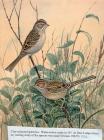
9
...After I did all the bird work, I used to go and pick up flowers and put them on and paint them there-wildflowers--because I knew Betsy was so interested in them.So would you ever take your paints outside and paint?
Oh yes, quite often. At Swan River, nearly every day, and same in Duck Mountains-there was no mosquitoes or anything.
But not in Winnipeg, or Deer Lodge?
Oh no. We went out once, come back home with specimens you know.
Mmmhmm.
It's easier to paint indoors.
Mmhm, certainly. Ah…
But you were saying, that there was a ditch that certain kinds of birds used to come on in the spring…
Oh yeah, the ditch on the east side of the large Strathcona estate.
Yeah.
Okay.
And there's willows growing all along it. They go over a mile right up to Saskatchewan Avenue, where the railroad tracks were. And then in the spring, there'd be all kinds of different warblers, by the dozens. Black ducks, and thrushes and even Rails, little water birds would show up. But it was a wonderful attraction. And in the open woods, near the farm, it was habitat suited to a smaller bird, like song sparrows, clay-coloured sparrows and nuthatches, chickadees and I used to spend a lot of time there. And I got interested in the Clay-coloured, because they say it would be nice if had something like that, to go by. So I spent two summers studying the Clay-coloured…
He'd sit there and he counted every time the birds came back and how many worms they had. You know, they wouldn't drop around here, they'd go flying far.
10
BIRD STUDIES 1931-1936By this time I had decided that my studies would be entitled "Birds of the Deer Lodge Area." - the woods and open spaces to the west of our home. The setting could not have been better and all within walking distance!
THE SILVER HEIGHTS FARM 1930
The Silver Heights Farm, formerly the Lord Strathcona Estate (1857), lay immediately west of Deer Lodge and for the purposes of our study was included in the area known as the Deer Lodge area.
The farm was bordered on the south by the Assiniboine River, on the north by Saskatchewan Avenue - distance of 2 ½ miles. It's width was approximately ¾ of a mile (from the lane of Conway Street to the lane of Davidson Street) and the overall area, some…acres.
Within its boundaries was to be found a wide variety of habitat, suited to water, woodland and upland birds.
Along the river, gravel and mud bars were exposed at low water, attracting transient shorebirds, gulls, herons and the occasional bittern, while the river itself played host to migrating waterfowl. The high, steep, clay banks afforded nesting sites for a colony of Bank Swallows, a few Rough-winged Swallows and at times, a pair of Belted Kingfishers.
Trees grew to the edge of the river bank. These were bur oak, with an undergrowth of hazelnut, willow, chokecherry, Saskatoon and hawthorn.
Portage Avenue cut across fifty yards from the river, the oak woods continued on the north side for some distance, gradually giving way to stands of aspen poplar.
These woods occupied a large portion of the south end of the farm and contained many fine old trees. Birds associated with oaks included both Eastern and Western Kingbirds, Eastern and Western Wood Pewees and a surprising number of Cedar Waxwings. Ruby-throated Hummingbirds, too, built their quaint little lichen-covered nests on the gnarled and lichen-covered branches of the oaks, where they were amazingly camouflaged. Other residents on occasion were Cooper's Hawk and a Broad-winged Hawk.
Half way up the farm, poplar woods predominated. Here in the lower area, they were inundated each spring with several inches of water. These wet areas were the home of great choruses of frogs which trilled in magnificent volume, especially at night.
Several pairs of Ruffed Grouse nested in the poplar woods and for a number of years, a bird with chestnut-red ruff and tail lived in the area.
The northern half of the farm had formerly been sown to various crops, but with disuse, had reverted to short grass. It was only lightly grazed and during the last years that we knew it (from 1933 on) only a few horses were kept for riding purposes.
On the west side of this open grassland, two groves of oak encroached and adjoining one of these was a small, willow-bordered marsh. One or two pairs of crows regularly nested in the oaks, with once a pair of Horned Owls and a pair of Broad-winged Hawks.
The little marsh harboured a small colony of Red-winged Blackbirds, usually one or two pair of Sora Rails, a Short-billed Marsh Wren and a Yellow Warbler.
Ninety species of wild flowers were recorded in this area, among them being the large and small lady slippers, coral root orchid, wood lily, bottled gentian, nodding trillium, wood violet, hoary puccoon, columbine, blazing star, monarda, prairie crocus, wild roses and wild sunflower.
DEER LODGE, JUNE 1950 FROM FIELD NOTES
"The entire southern half of Silver Heights Farm has been taken over for a housing development. Practically all the extensive stands of oak and poplar have been destroyed. None of the old bird haunts remain.
Gone are the oaks and poplars; gone are the woodland trails that wound through dappled sunshine to secluded glades, where clumps of snowberry mingled with willow and hawthorn. The bushy little marsh is no more. The patches of open prairie, once the home of the Upland Plover, Chestnut-collared Longspur and Western Meadowlark, have vanished under pavement.
The roar of jetliners, the hustle and bustle of traffic now reign where once the plaintive song of the White-throated Sparrow and the haunting call of the Whippoor-will came upon the stillness of peaceful days".
The complete summary of this study is recorded in a large photo album. Now in the University of Manitoba Archives (2004). Included are 12 pages of photos of the area in winter and summer, 24 pages of nests, some colour prints, pen and ink and pencil drawings, together with text covering special studies and overall data on spring and fall records on migrations.
On the open grassland, which, with the exception of a portion at the extreme north end, was dry and sun-baked, Killdeers, Western Meadowlarks, Horned Larks and Savannah Sparrows were yearly nesters and on occasion, a pair or more of Chestnut-collared Longspurs, Sprague's Pipit and Bobolink, the latter generally found at the north end.
Thirteen-striped Ground Squirrels became common in the dry years and their burrows dotted the area; in one of these a pair of Burrowing Owls nested. By 1933 the Richardson Ground Squirrel or flickertail moved in and the thirteen-striped declined in numbers. On the heels of the flickertails, a badger came upon the scene and lived well on the squirrels for one summer, finally disappearing in the late fall.
Traversing the length of the farm along its east side, was a deep ditch paralleling the railroad embankment. This was a spur line that connected with the C.P.R. branch line along Saskatchewan Avenue. Long abandoned and the rails torn up, only a few of the old log ties still remained on the embankment.
On each side of this ditch, which held water most of the year and was well-filled following snow-melt in the spring, willows grew profusely, almost along its entire length.
It was a natural "highway" for hordes of migrating sparrows, warblers and blackbirds in both spring and fall.
Total species of birds recorded was 233. This included year-round residents, summer residents, spring and fall migrants and winter visitors. Total breeding species was 83.
SOME ADDITIONAL DATA FROM 1937-1938
Accompanying is map of the area and description of the various habitats and some of the species found there.
Number of species recorded 233
Number of species nesting 83
Number of wildflowers recorded 90 species
11
Page 1 of the 'Birds of Deer Lodge' report by Angus H. Shortt.1931
Deer Lodge, Winnipeg, Manitoba, Canada
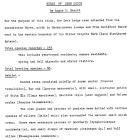
13
I think of the ones at Deer Lodge north of the Strathcona estate, it was an open prairie. The horned larks, the Sprague's Pipit ….it's a lark really…Yes, it's a lark.
And there'd be ground squirrels, and actually, on some parts of it, there were boroughs by the bigger rodents. And one of the nicest things was the burrowing owls.
Do you remember seeing the burrowing owls?
Oh, yes. They took over an abandoned nest, eh? A borough of ground squirrels.
Ground squirrels, yes.
And wonderful things.
Yeah, they're so cute. The way they turned their heads almost right around…and their feet. They're legs seemed to be out of place, somehow. We used to go out birding a lot, just the two of us.
14
Grey Partridge Painting by A.H. Shortt1945
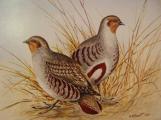 Credits:
Credits:Image courtesy of: Archives of Manitoba, Shortt, A.H. 1, N1379
